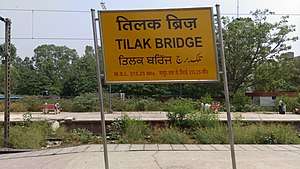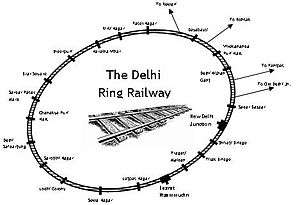Delhi Ring Railway
Delhi Ring Railway is part of the Delhi Suburban Railway services. The Ring Railway is a circular rail network in Delhi, which runs parallel to the Ring Road and was conceived during the 1982 Asian Games. Started in 1975 to service goods, it later upgraded for the Games, when 24 additional services were started. Its circular route is 35 km (22 mi) long, which the train takes 90–120 minutes to complete, both clockwise and anti-clockwise, via Hazrat Nizamuddin Railway Station, from 8am-7pm. With a return ticket for the entire journey costing ₹12, compared to with Delhi Metro, which is around ₹60, it is preferred by poor and middle-class families.[1] It runs seven clockwise and six anti-clockwise trains at a peak frequency of 60-90 min., during the morning and evening rush hours. Prior to the 2010 Commonwealth Games, 7 stations near the sports venues, namely Chanakyapuri, Sarojini Nagar, Inderpuri Halt, Lajpat Nagar, Sewa Nagar, Lodhi Colony and Safdarjung, received a facelift at the cost of ₹3 crores.[2][3]
| Delhi Ring Railway | |||||||||||||||||||||||||||||||||||||||||||||||||||||||||||||||||||||||||||||||||||||||||||||||||||||||||||||||||
|---|---|---|---|---|---|---|---|---|---|---|---|---|---|---|---|---|---|---|---|---|---|---|---|---|---|---|---|---|---|---|---|---|---|---|---|---|---|---|---|---|---|---|---|---|---|---|---|---|---|---|---|---|---|---|---|---|---|---|---|---|---|---|---|---|---|---|---|---|---|---|---|---|---|---|---|---|---|---|---|---|---|---|---|---|---|---|---|---|---|---|---|---|---|---|---|---|---|---|---|---|---|---|---|---|---|---|---|---|---|---|---|---|---|
| Overview | |||||||||||||||||||||||||||||||||||||||||||||||||||||||||||||||||||||||||||||||||||||||||||||||||||||||||||||||||
| Type | Suburban Rail | ||||||||||||||||||||||||||||||||||||||||||||||||||||||||||||||||||||||||||||||||||||||||||||||||||||||||||||||||
| System | Delhi Suburban Railway | ||||||||||||||||||||||||||||||||||||||||||||||||||||||||||||||||||||||||||||||||||||||||||||||||||||||||||||||||
| Locale | Delhi, India | ||||||||||||||||||||||||||||||||||||||||||||||||||||||||||||||||||||||||||||||||||||||||||||||||||||||||||||||||
| Termini | Hazrat Nizamuddin Hazrat Nizamuddin | ||||||||||||||||||||||||||||||||||||||||||||||||||||||||||||||||||||||||||||||||||||||||||||||||||||||||||||||||
| Daily ridership | 3,700 | ||||||||||||||||||||||||||||||||||||||||||||||||||||||||||||||||||||||||||||||||||||||||||||||||||||||||||||||||
| Operation | |||||||||||||||||||||||||||||||||||||||||||||||||||||||||||||||||||||||||||||||||||||||||||||||||||||||||||||||||
| Opened | 1975 | ||||||||||||||||||||||||||||||||||||||||||||||||||||||||||||||||||||||||||||||||||||||||||||||||||||||||||||||||
| Operator(s) | Northern Railway | ||||||||||||||||||||||||||||||||||||||||||||||||||||||||||||||||||||||||||||||||||||||||||||||||||||||||||||||||
| Character | At Grade | ||||||||||||||||||||||||||||||||||||||||||||||||||||||||||||||||||||||||||||||||||||||||||||||||||||||||||||||||
| Technical | |||||||||||||||||||||||||||||||||||||||||||||||||||||||||||||||||||||||||||||||||||||||||||||||||||||||||||||||||
| Line length | 35 km (22 mi) | ||||||||||||||||||||||||||||||||||||||||||||||||||||||||||||||||||||||||||||||||||||||||||||||||||||||||||||||||
| Track gauge | 1,676 mm (5 ft 6 in) broad gauge | ||||||||||||||||||||||||||||||||||||||||||||||||||||||||||||||||||||||||||||||||||||||||||||||||||||||||||||||||
| |||||||||||||||||||||||||||||||||||||||||||||||||||||||||||||||||||||||||||||||||||||||||||||||||||||||||||||||||
The ring-railway service was introduced on a track laid in 1975 so that the large number of goods trains originating, terminating, or passing through the city, could bypass the main passenger stations at New Delhi, Old Delhi and Hazrat Nizamuddin.[3] The track was called the 'Delhi Avoiding Line'. Today, however, the Northern Railway's service for passengers within the city has become something which Delhiites are avoiding. There are 12 electric trains on the ring rail. Only three of the twelve EMUs run to full capacity. The rest have just 1-2% occupancy. The ring railway starts and ends at the Hazrat Nizamuddin Railway Station with trains running in both clockwise and anti-clockwise directions around the city.

Popularity with commuters
The system is not popular among individual travelers and has been a total failure as far as public transport is considered.[4] Delhi Ring Railway is considered as an example of failed mass transit system. The major reasons for failure of the system are lack of workable connections to other methods of transportation as well as a low-density population in the areas of reach. Making matters worse, the station exits usually open into narrow, dirty alleyways - often more than a kilometre away from the main road. The network is now utilized as a freight corridor, though limited passenger EMU train services are available during peak hours.
See also
References
- "The road around progress". Mint. 17 February 2012.
- "Changing Delhi map makes Ring Railway redundant". Indian Express. 22 February 2011.
- "Ring Rail service chugs into oblivion". Deccan Herald. 4 February 2012.
- "Ring Railway left behind as Delhi swells beyond boundaries". The Indian Express. 11 March 2016. Retrieved 8 July 2020.
